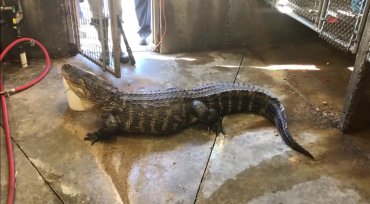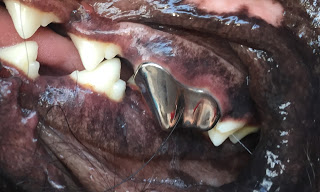Evicted Alligator Gets Legal Representation
Lauren Kruskall & Tristen Woods, Jungle Law
 'Katfish,' the 200-pound PET alligator was forcibly removed from his home, and was being represented in court by Tristen Woods and Lauren Sierra. The alligator's owner, Sean Casey, fed Katfish a diet of chicken nuggets from Wendy's. Tristen and Lauren explain the situation and what the future holds for the pet reptilian.
'Katfish,' the 200-pound PET alligator was forcibly removed from his home, and was being represented in court by Tristen Woods and Lauren Sierra. The alligator's owner, Sean Casey, fed Katfish a diet of chicken nuggets from Wendy's. Tristen and Lauren explain the situation and what the future holds for the pet reptilian.
Years ago, an alligator and his owner, Sean Casey, were evicted from their house in Kansas City, Missouri. The alligator was then removed from Sean Casey's possessions. Sean Casey then retained the services of Jungle Law Attorneys Lauren Kruskall and Tristen Woods.
The Jungle Law practice revolves around exotic pets. They also do a lot of pro bono work for the animal community in Kansas City, focusing mainly on exotic animals. You really wouldn't think there's many exotic animals in Kansas City in the middle of the Midwest, but you'd be surprised how many calls they get regarding cases like this.
Surprisingly, it's not illegal to own an alligator or other exotic pets in Missouri. However, they have to live outside the cities. So for example with Katfish, the alligator, if Mr. Casey would have relocated about 20 miles outside of Kansas City, he could have had Katfish back and lived happily ever after with him.
Lauren and Tristen tell us that this was not their first alligator representation. It was actually their fourth. However, in the prior case, one person had three of them and they were able to work out a deal.
Because of who they are and their name of Jungle Law, Lauren thinks that animal owners, not just in Kansas City, but pretty much anywhere, when they hear about them, they automatically think that they're the law firm that fits with what they have and they reach out to them. Obviously, what they care about the most is having the animals ending up in the best situation possible. Sometimes. that isn't always what the client necessarily wants. So it can be a tough challenge. However, in the case of Katfish, his owner was actually a really wonderful owner, not abusive or anything like that. He was very caring and so it is fortunate that this had a happy ending.
Katfish was a large alligator and weighed around 225 pounds and was about 8 feet long. Katfish was also a big fan of chicken nuggets. In fact, he actually only liked chicken nuggets from Wendy's. His owner would frequently take Katfish through the drive-thru at Wendy's and all of the employees knew him.
Sean Casey got Katfish when he was about 14 inches long and about the size of a ruler. Sean raised him ever since and didn't know that it would grow into this kind of love affair and attachment. Katfish even became part of the family. Sean never worried about his family when Katfish was around. Katfish was so docile, Sean used to take him out on walks. Katfish also basically slept right next to Sean.
Katfish was always comfortable and had all of his needs met. Sean made him a nice, almost like a hot tub setting, little lagoon in his front living room for Katfish. When Sean would watch TV, Katfish was right at his feet.
Relationships with wild animals are pretty remarkable, but their owners train them to learn to trust them. This is something that the Jungle Law attorneys have seen before. However, they are still wild animals. The Jungle Law attorneys are frequently around these animals, but they are still very weary about them. Fortunately, nothing's happened to them yet.
 Katfish was placed Monkey Island in Greenwood, Missouri. They attorneys think that this the best place for him at that time. They know that Sean really loved spending time with Katfish and probably eventually wanted to have him back, but the most important thing with an animal like this is that they have the continued care and a place where they can be financially supported.
Katfish was placed Monkey Island in Greenwood, Missouri. They attorneys think that this the best place for him at that time. They know that Sean really loved spending time with Katfish and probably eventually wanted to have him back, but the most important thing with an animal like this is that they have the continued care and a place where they can be financially supported.
So do Lauren and Tristen think that Sean Casey should have been allowed to have Katfish back if he moved outside the city? Lauren explains that there are two things at work here that neeed to be in play. First of all, obviously Sean needed to be following the law and then the next important thing is making sure that he had the wherewithal to take care of Katfish. Most certainly Sean Casey had the heart to take care of Katfish. He's a great animal parent. A lot of times people get these animals and are irresponsible and don't really care, but one of the great things about Katfish, is he was very plump because he was well fed and well taken care of.
The good thing about Katfish being at Monkey Island was that they had the wherewithal to take care of him. The laws were being followed and Katfish was in the best hands possible. But whoever can provide the best outcome was probably the best place for Katfish to be.
Jungle Law does represent Sean Casey and they tell us he received a citation for having an exotic animal within the city limits. Jungle Law was working with the prosecutor in Kansas City to see what they could do regarding Mr. Casey in that instance.
Surprisingly, Sean Casey had signed the rights of Katfish over to Dana Savorelli at Monkey Island. Sean had to do this because animal control was willing to give Katfish back, but Sean had to have a suitable home for him. If Sean did get Katfish back and he was found inside the city limits a second time, the next time Monkey Island might not be able to have the advantage of being able to take him back again.
Lauren and Tristen feel that Sean was still living in the city limits and didn't have the support to take Katfish back. No one wants Sean to take on that burden of having to try to find another place outside of the city right.
Most people think that Katfish was just a reptile and Sean will get over it. But Sean loved his alligator. He even took care of him better than himself. Alligators in captivity live around 70 years, so it's a big time commitment to have an animal like that.
Along with Katfish, Kansas City Animal Control also confiscated three pythons and a rabbit. The rabbit was named 'Dinner' and was the most beloved animal that Sean had. Sean was at a relatives' house one rainy day in the summer and there was this baby rabbit outside on the driveway. Sean didn't think it could take care of itself, so he took it in and raised it. Because it was a wild animal, animal control unfortunately let the rabbit go.
It's nice to have rescue groups willing to take these animals in, because sometimes when animal control finds these animals, they have to do the quickest solution possible. But when there are rescue groups available for these wild animals to go to right away, it provides a safe haven instead of them being put down or something else along those lines.
Besides representing people like Sean Casey, Jungle Law also works on an animal abuse law bills. The goal is to raise misdemeanors on animal abuse to felonies and to create an animal abuser registry list.
Visit Website
Stressed People Have Stressed Dogs
Dr. John Huber, Clinical Forensic Psychologist
 Dr. John Huber says happy owners generally have happy pets. Alternatively, stressed owners tend to cause their pets to be anxious. This anxiety can cause a myriad of canine behavior problems. However, research shows that if you're the calm, cool, collective kind of person your pet will be relaxed too.
Dr. John Huber says happy owners generally have happy pets. Alternatively, stressed owners tend to cause their pets to be anxious. This anxiety can cause a myriad of canine behavior problems. However, research shows that if you're the calm, cool, collective kind of person your pet will be relaxed too.
Dr. John Huber is a Clinical Forensic Psychologist and said the study involved looking at bad behavior in animals. They started realizing, first of all, it's kind of subjective. This is because one person might think it's bad behavior, but from someone else's point of view, they might think the dog just doesn't know what your expectations are and the they're acting like a dog; they are not acting poorly.
As researchers started looking at this, which this was all subjective from individuals, they stumbled on this idea of, 'How do you rate yourself?' Do you rate yourself as being relatively stressed and relaxed or do you rate yourself as being highly stressed? What they found out was that the higher your stress level was, the worst your animal behaved in your perception.
A lot of that is because dogs have better senses than we do. First of all, they can hear things farther away than we can; about four times farther when it comes to low volume sounds. They also have a much wider range in pitch so they're able to pick up on things with us.
If you go back to some of the studies they've done with different horses and stuff, it was shown that they could pick up on your internal functioning. This includes how your heart rate is and your respiration. So dogs are much more sensitive to our emotions. And you add on top of that the evidence to support this, is that there are seizure dogs out there that can identify you starting a seizure 45 minutes to a half an hour before you actually have the seizure. So they're very intuitive and they pick up on our senses and how we're feeling better than other human beings.
Dr. Huber tells us about his dog that he adopted from the shelter. The dog was an abused dog and he rescued her this summer. To him it was obvious a male person abused the dog. The dog has finally come around and actually sleeps on him during the night. The dog has made a breakthrough and she doesn't run when he walks in the room and things like that anymore. So it's very difficult to pick up on how much of that the abuse or maybe the dog picking up on stuff that he doesn't know he's transmitting.
Is there a way you can make your dog calmer? Can you just act calmer, or would your dog see right through that?
Dr. Huber explains that from a psychologist's standpoint, we know that our bodies react and if we start faking like we're calm, our body will start catching on and actually over time start faking calm with you. So in essence, it will make you calmer. It's not going to happen tomorrow, but if you're stressed out and you want to start doing that, it'll probably take six to eight weeks for your own body to catch on. And once that happens, your pet should go right along with you.
 Many dogs have separation anxiety on a daily basis, while others couldn't care less if you left the house. Is separation anxiety something that is reflected upon our disposition?
Many dogs have separation anxiety on a daily basis, while others couldn't care less if you left the house. Is separation anxiety something that is reflected upon our disposition?
One of the psychologists in Dr. Huber's office has two dogs that are on Prozac, which helps those dogs and their separation anxiety. What they found out is that the dogs are not destroying things in the house that they used to nor driving the neighbors crazy because they're barking all the time. However, the dogs were already very stressed out animals. He got them from a rescue also and they were already very anxious and shaking all the time and very afraid to go on walks. Now with the Prozac, all of that's kind of gone away and he is able to walk the dogs. They even moved to a new neighborhood and the dogs had no problem adjusting to the new parks.
Anxiety in our pets is a real thing. A lot of it is caused just like in humans. We worry about 9,900 different things that will never go wrong. So that causes our anxiety. Dr. Huber thinks the dogs have had some traumatic experience in their life before us, and his experience, and his partner's experience with his dogs, is they're afraid of what might happen next, because they've had unsettled or uncertain areas in their life. And that's where our stress brings in that uncertainty that scares the dogs and causes their trauma.
So should you be firmer with your pet and instead of picking them up at every little thing and coddling them and telling them in baby talk that everything's going to be okay?
Dr. Huber explains it a lot like human babies. If we coddle them, we don't teach them the skills they need to be resilient. He feels it's the same way with our pets. We need to give them space to be the animal that they are, whether a dog or a cat. However, because not every dog likes to be petted and not every cat likes to be petted, they will introduce you to their level of the nurturing they need and they'll come to you for that. Pay attention to what they have to say. Now if you're stressed out and you don't have time for that, we end up pushing ourselves on them, which again creates more anxiety in the pets.
What Dr. Debbie sees in her practice is that people that think that living within our household is all that a dog needs to be a fulfilled animal. She feels that a lot of this goes back to early socialization. You know when you adopt a pet it has some preexisting phobias, but that's a different thing. As pet owners, we Americans can do a far better job in socializing and exposing our animals to things and not making them so dependent on us. They can sleep all day long unattended and don't have to be entertained. We don't need to feel bad about leaving them if we've socialized them in the right way. She states this is the big change all Americans really need to do.
Dr. Huber says that's where the car ride comes in with his pet. He has a Boxer that needs lots of room and he doesn't have lots of room where he's living. So he takes him for a car ride almost every single day. He takes him down to the park that butts up against a green space. There are deer there and they come out to the park right before sunset. He says his dog is more afraid of the deer than they are of him. However, his dog goes out and runs with the deer and they chase her. He says it is a full-blown run at full speeds for about 35 to 45 minutes. Afterwards, his dog comes and lies down and spreads herself out on the grass and tries to cool off, and then she's done.
 What about the time that we spend ignoring our pets while we are texting and on social media and Facebook, are our animals are picking up on this and is it driving them crazy? Absolutely, according to Dr. Huber. He explains when he is on the phone, his Boxer jumps up on the bed, because the bed and the couch are her safe zones with him. So if his dog wants him to pay attention to her and he gets a text, she puts her foot right on the phone and pulls it away from his face. She also likes the way he scratches her back and massages her hips. So when her hips are bothering her, she will stick them right in his face.
What about the time that we spend ignoring our pets while we are texting and on social media and Facebook, are our animals are picking up on this and is it driving them crazy? Absolutely, according to Dr. Huber. He explains when he is on the phone, his Boxer jumps up on the bed, because the bed and the couch are her safe zones with him. So if his dog wants him to pay attention to her and he gets a text, she puts her foot right on the phone and pulls it away from his face. She also likes the way he scratches her back and massages her hips. So when her hips are bothering her, she will stick them right in his face.
Dr. Huber also tells us about his 13-year-old tomcat who has had the world to himself until this summer when the Boxer came in. The cat is now figuring out how he can manipulate the dog's behavior. He's figured out the best way to do this is to be more involved with Dr. Huber. Before the dog, the tomcat didn't want anything to do with him. The cat was the ruler and Dr. Huber was there to bow down to him. But now the cat sees the dog and he's like, 'I'll just go and sit next to them and I'll try and get up in daddy's lap during dinner,' which just drives the dog crazy and torments her.
The close bond between dogs and their owners has earned them the title of 'Man's Best Friend.' But, the relationship between humans and dogs is so close; humans can influence their temperament. So - just slow down and relax and your pet will too!
Visit Website
Will Your Dog's Chew Bone Injure Her Teeth? - Dr. Debbie
 Even veterinarians can make bad choices when it comes to their pet's health. I learned this when I discovered my dog, Nikki, had a broken tooth. The cause was a chew item I thought was a safe option for her to gnaw on. But I was wrong - no chew item is risk free. Sadly my Nikki had to crack three teeth for me to learn that lesson.
Even veterinarians can make bad choices when it comes to their pet's health. I learned this when I discovered my dog, Nikki, had a broken tooth. The cause was a chew item I thought was a safe option for her to gnaw on. But I was wrong - no chew item is risk free. Sadly my Nikki had to crack three teeth for me to learn that lesson.
Oh yes, it was three broken teeth! But more on that later...
Considering Chew Options
What chew options are there? As the owner of a large powerful chewer I considered the possibilities for my dog. She has a sensitive stomach and cannot tolerate edible bones or preserved rawhide products. Thank goodness, because feeding my dog pig snouts or pizzles just makes me want to gag. I'm not a fan of real bones - too many patients with broken teeth, gastrointestinal blockages and even one with a bone shard migrating through the side of a dog's throat. Soft plastic toys don't survive the first two minutes with her, and plush toys quickly lose eyes, limbs and squeakers with her near surgical precision. So I chose to offer synthetic Nylabone style bones to deal with her chewing drive. Nikki loves the flavors and happily chews away for long periods of time. When the bone looks damaged, I throw it away. It seemed like the perfect solution for a vigorous chewer.
Discovering Her Broken Tooth
While brushing Nikki's teeth, I noted a fracture of her upper fourth premolar tooth. This is the largest cheek tooth on a dog or cat's upper jaw, which serves to chew and grind food. The outer layer of the tooth was sheared off, just like a shelf of ice cracking off an iceberg. This type of fracture is common from dogs chewing on an object harder than tooth enamel. Common culprits for this type of tooth damage include antler chews, Nylabones, real bones or ice.
What to Do With Broken Teeth?
Not all tooth fractures are created equal. An uncomplicated tooth fracture is one in which only the enamel is broken. The tooth is vulnerable to further injury but is not immediately causing the pet pain. A complicated fracture is one in which the break extends beyond the enamel into the pulp chamber.
The pulp of a tooth is the inner layer where the nerve and blood supply runs. Exposure of the pulp not only causes pain, but serves as direct pathway for oral bacteria to cause a tooth abscess or spread through the bloodstream.
How to Treat a Tooth Fracture?
A complicated tooth fracture requires either a root canal or surgical extraction. Leaving a complicated tooth fracture untreated is NOT an option. These teeth hurt and shouldn't be ignored. Pets won't whine or cry out in pain with broken teeth, but rather suffer in silence. But after a diseased tooth is addressed, owners commonly note their pet's overall activity and attitude improve.
 The preferred treatment for a complicated tooth fractures is a root canal. During a root canal the contents of the pulp are removed, filled in, and the tooth is sealed. After the root canal therapy the tooth is still functional for normal chewing activities.
The preferred treatment for a complicated tooth fractures is a root canal. During a root canal the contents of the pulp are removed, filled in, and the tooth is sealed. After the root canal therapy the tooth is still functional for normal chewing activities.
If a root canal cannot be pursued, then the tooth should be surgically extracted. This removes the source of pain and potential infection. However, surgical removal of broken teeth may affect the pet's ability to chew on that side in the future.
Uncomplicated tooth fractures aren't treated as above, but rather may need outward support of the area with bonding restoration.
My Dog's Dentist Visit
Dental cleanings and extractions are a daily service at most veterinary practices, but root canals and tooth restorations aren't commonly available at general practices. I knew I could pull Nikki's tooth, but to save this tooth in my young dog, I'd need to see a veterinary dental specialist.
Nikki and I arrived at Arizona Veterinary Dental Specialists where she was evaluated by Dr. Chris Visor who determined that she had an uncomplicated fracture of her premolar and small uncomplicated breaks on two molars.
Her premolar fracture was limited to the enamel, luckily sparing pulp damage, which means she wasn't in pain. But the damaged tooth would be at risk for further injury, so she was fitted for a restoration with a metallic crown (porcelain isn't durable in pets so it's not commonly used). The two other broken teeth had minor damage, so the rough edges were drilled smooth and the tooth surface bonded.
Lesson Learned
After her crown placement, Nikki can't chew on hard chew bones like before. If she did, it could risk damage to her crown as well as her other teeth. Veterinary dentists warn dog owners to try this test of your dog's chew item - if you whack your knee with your dog's chew item and it hurts you, it'll likely break her teeth.
Now I can only imagine scores of dog owners going to their doctors with knee pain….
Take Away Tips: Can You Detect Your Pet's Broken Tooth? Most broken teeth are detected during a physical exam by your veterinarian, but some observant pet owners may discover clues to their pet's broken tooth.
1. No complaining. Don't expect your pet to cry or whine. People complain loudly when a tooth hurts, but pets just don't verbalize dental pain.
2. Uneven tartar accumulation. Due to tooth pain, the pet chews on one side more, the "good side." Tartar builds up more on the "bad side."
3. Dark spot on tooth. Enamel is evenly white, but darker or grey spots could indicate exposed pulp or dentin at the site of a fracture.
4. Draining wound present below the eye. A broken upper premolar or molar with an infected root can cause a draining wound under the eye.
If you notice any of these signs, get your dog to a veterinarian right away.
Featured veterinarian known as "Dr. Debbie" on national pet radio program, Animal Radio. Ebook author of "Yorkshire Terriers: How to Be Your Dog's Best Friend"; "Pugs: How to Be Your Dog's Best Friend"; "Mini Schnauzers: How to Be Your Dog's Best Friend"; and "Shih Tzu: How to Be Your Dog's Best Friend." Dr. Debbie's books.
Visit Website
 Listen to the entire Podcast of this show (#1156)
Listen to the entire Podcast of this show (#1156)





